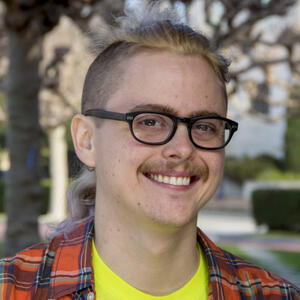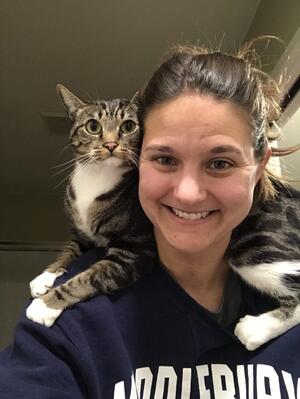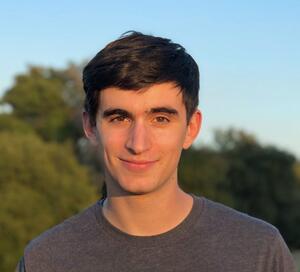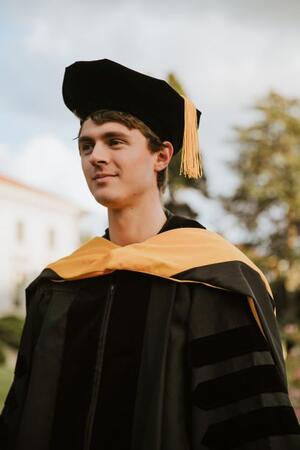Congratulations to our 2020 Neuroscience PhD Program graduates: Charles Frye, Jocelyn Breton, Zeke Barger, and Franklin Caval-Holme!
Read our Q&A with them below to learn their biggest discoveries, future plans, and words of advice.
Charles Frye, DeWeese and Bouchard labs 
Thesis: Finding critical and gradient-flat points of neural network loss functions
What is the most interesting thing you discovered in your research here?
I studied artificial neural networks, the technology powering the current wave of new AI and machine learning techniques. I was particularly interested in why these networks work at all, despite the total lack of any mathematical guarantees. While trying to reproduce some key results from the literature, I noticed that the methods being used to investigate the networks had a flaw. In the presence of a particular geometric structure we christened a “gradient-flat point”, methods for understanding why neural networks don’t fail would, themselves, fail. It turns out, these gradient-flat points are everywhere for neural networks!
What are you doing next?
I am joining a startup called Weights & Biases. They make a tool for organizing, sharing, and reproducing machine learning-based experiments. I will be producing educational content using their tool and using it to teach teams of software engineers about neural networks and machine learning.
Do you have any advice for your fellow students?
Question every figure, trust no one’s results (especially your own), and read old papers.
Jocelyn Breton, Kaufer lab, previously Fields lab 
Thesis: The role of the prefrontal cortex in motivation and stress behaviors
What is the most interesting thing you discovered in your research here?
One of my favorite projects I worked on explored the development of prosocial behaviors in rats, as well as the neural circuits that might be involved. Previously, it’s been found that adult rats only help rats of the same strain, showing an interesting in-group bias. We wanted to see if this was true for adolescent rats as well, so we tested if juvenile Sprague Dawley rats would help open a restrainer to release a trapped rat of another strain. The behavioral finding was super cool — basically, the young Sprague Dawleys DID help open for the Long Evans strain, suggesting the young animals don’t have the group bias we see in adults! I’m still processing the brain data, but it’ll be interesting to see which brain regions are differentially activated in the juveniles compared to the adults.
What are you doing next?
I’ll be starting a postdoctoral fellowship with Dr. Kevin Bath on the east coast this fall (although nothing is official yet with all of the hiring freezes!)
Do you have any advice for your fellow students?
Build a community around you, both within and outside of the university, early on. Don’t be afraid to put yourself out there! Seek out additional mentors, whether that be students or faculty — most people are willing and eager to listen and help! Know that you are not alone — many have walked the same path before and dealt with the same struggles — and they can offer advice!
Zeke Barger, Dan lab 
Thesis: Robust, automated sleep scoring by a compact neural network with distributional shift correction
What is the most interesting thing you discovered in your research here?
With the right data processing procedures in place, artificial neural networks can be trained to perform a difficult task that most sleep researchers do manually.
What are you doing next?
I’ll be starting as a fellow in the Insight Data Science program.
Do you have any advice for your fellow students?
If you’re feeling stuck on a problem, remember that you’re surrounded by people who want to help you succeed. Students, postdocs, professors — they’re all ready to lend a hand if you need it.
Franklin Caval-Holme, Feller lab 
Thesis: The neural basis of neonatal light detection
What is the most interesting thing you discovered in your research here?
Before the developmental onset of image-forming vision, newborn mammals have behavioral responses to light. These behaviors are driven by retinal ganglion cells that contain their own opsin and are thus intrinsically light-sensitive. I found that these intrinsically light-sensitive retinal ganglion cells are connected by gap junction ion channels, forming an electrical network that is critical for their full light sensitivity and sufficient, when coupling is enhanced through neuromodulation, to greatly increase light sensitivity.
What are you doing next?
I’m headed to Michael Do’s lab at Harvard where I will be a postdoc studying how light-evoked signals from the retina entrain circadian rhythms.
Do you have any advice for your fellow students?
Nature often does not work the way you predict, but have faith that you can make sense of it. If you do careful experiments, stick with a line of investigation, and test your assumptions, you’re going to find something interesting. By way of example, it turned out the gap junction coupling between intrinsically light-sensitive ganglion cells may have little to no role in the main light-evoked behavior I study. This was a real surprise and something of a bummer at the time but this observation is now leading us in an interesting new direction. Also, remember to relax, make friends, go outside, pursue hobbies or do whatever else you want to do. This PhD is going to take most of your twenties, which should be a fun time in life. If you’re happy, you will probably do better science also.
View all Neuroscience PhD Program graduate Q&As.
Original Publication Date: May 27, 2020
